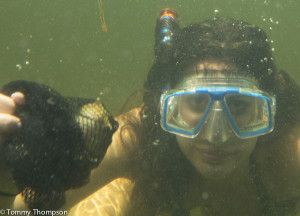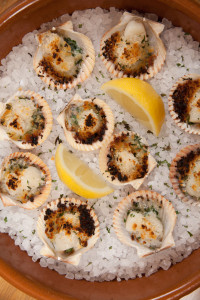Bay Scallop Season To Begin on Florida’s Nature Coast, June 27, 2015

The 2015 bay scallop season opens June 27th. Ports along Florida’s Nature Coast from the Pasco/Hernando county line north to the Mexico Beach Canal are expecting a record “crop” and are prepared for a very busy couple of months. This year’s season begins on June 27 and ends on September 24, giving everyone plenty of time to scoop up some of these cherished critters.

Bay scallops are usually found atop shallow grass flats in clear salty water, making them easy prey for folks of all ages and abilities. Steinhatchee, Keaton Beach, Spring Warrior, and St. Marks have been traditional scalloping hotspots. Ports with darker or less salty water (Yankeetown, Suwannee, Waccassassa—all on large riverine estuaries) are less likely to have any large concentration of scallops. While there are a few spots where scallops can be picked up after wading from shore, for the most part everyone reaches the scallop grounds by boat. There, snorkeling and scooping them up by hand is the preferred technique for a successful bag limit. A mesh bag comes in handy when snorkeling, as I don’t recommend putting scallops in your bathing suit pockets. They can pinch!
Scallops don’t necessarily appear at the same spot, year after year. However, local marinas, motels and tackle shops are pretty good about sending out spies in advance of the season and sharing information with visiting scallopers. Or if you’re embarrassed to ask, just head out of your favorite port on any day but opening day, and scan the horizon to find the “fleet”. Another option is to hire a local guide. Guides can be found on the websites of local marinas, and using guides’ services allows you the advantage of scalloping with someone who likely has been on the water many times before you arrive.
The bay scallop harvest is regulated by the Florida Fish and Wildlife Conservation Commission (FWC). Strict rules apply, especially to daily bag limits. Each scalloper must possess a valid Florida Saltwater Fishing License (or have an exemption) and is limited to 2 gallons of scallops, in the shells, per day. Each boat is limited to a maximum of 10 gallons of scallops, in the shells, even if there are more than 5 scallopers aboard. An individual limit of scallops usually results in about a pint of meat; a boat limit produces about a half-gallon.
No discussion of our bay scalloping season can take place without mentioning safety. This is without a doubt the busiest time on Big Bend waters and you can expect crowded boat ramps, marinas and waterways. And once a few scallops are found in a particular area, hundreds of boats may gather in a small area. Here, it’s mandatory to run at idle speed within 300 feet of boats flying “diver down” flags or divers towing buoys with flags. Having a lookout in addition to the boat operator is a good idea, and please, don’t drink and boat.
A day of scalloping is about as much fun as you can have on the water. Kids can explore the marine environment while Mom and Dad gather scallops for dinner. Or vice-versa. The only danger is that there’s always a snorkeler who forgets to apply sunscreen, returning home with their back lobster-red. Or the possible addiction to the unbelievable taste of bay scallops. This tasty species cannot be commercially harvested or sold, so what you catch is what you can eat. You’ll never again be happy with “restaurant scallops”.

